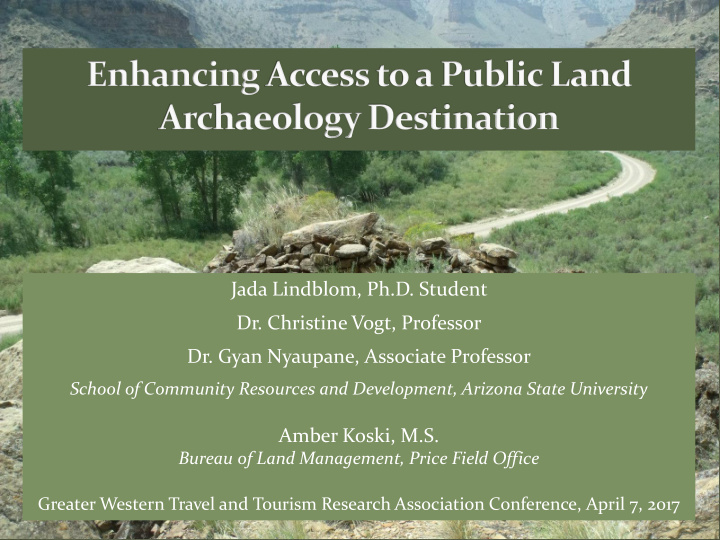



Jada Lindblom, Ph.D. Student Dr. Christine Vogt, Professor Dr. Gyan Nyaupane, Associate Professor School of Community Resources and Development, Arizona State University Amber Koski, M.S. Bureau of Land Management, Price Field Office Greater Western Travel and Tourism Research Association Conference, April 7, 2017
Bureau of Land Management (BLM) Nine Mile Canyon, Utah Archaeological significance Public engagement in public lands Local volunteers (especially tribal youth) Scientific and anthropological discovery
Public land in Utah Yellow = BLM Nine Mile Canyon: Carbon County, UT Desert/semi-desert Map source: https://www.ut.blm.gov/LandRecords /search_plats.cfm
Fremont culture – 2,000 to 700 years ago Much is still unknown and scholars don’t all agree Term may not refer to just one distinct group of people Generally, it is thought that they were a partially agricultural society, but social system is still mostly a mystery It is not completely understood why/how they “disappeared”
• Nine Mile Canyon is thought to be one of the best areas for Fremont archaeology; many sites are still unexcavated • Nicknamed “The World’s Longest Art Gallery”
The Nine Mile Canyon area isn’t currently as popular for outdoor recreation purposes as other Utah destinations in-depth recreation plan for the area has been underway Local mining activity led to recent road improvements Location not far off of US-191 is advantageous for tourism development Carbon County Office of Tourism has a growing online presence Not many other Utah destinations have this amount of accessible archaeological sites
S ometimes called “community archaeology” Involves engaging people in archaeological processes who are from outside of the profession Has been a topic and practice of growing interest and popularity in the last couple of decades (Source: Society for American Archaeology, 2016)
Archaeology, history and science: Creating a unique, hands-on educational experience Excavating at least one major pit structure Analyzing, synthesizing, and interpreting archaeological data for public benefit and scientific advancement Housing collection of artifacts at the Prehistoric Museum for public and scholarly access
Conservation, stewardship and community: Involving the community in a way that generates stewardship ethics, sense of place, pride in community Generating greater interest in Nine Mile Canyon as a visitor destination Introducing more people to native history, public lands, and outdoor experiences Building a sense of trust and appreciation for public land managers
Management approach of creating a joint venture (Huxham & Vangen, 2005) adds multidimensionality to what could be a more singular project Already established in the region: BLM – Price Field Office Prehistoric Museum (Utah State University – Eastern) Colorado Plateau Archaeological Alliance (CPAA) (nonprofit, expert staff) Montgomery Archaeological Consultants (previous work) ASU - New to Nine Mile but brings other strengths
1 – 5 year project TBD based on program success and funding factors Currently in Year 1 Current focus: volunteer outreach Particular attention on involving tribal youth from Uintah-Ouray communities Applied, place-based, experiential STEM experience Excavation begins Fall 2017
Volunteer Website http://ninemilevolunteer.weebly.com/
Other local community members engaged through volunteer and leadership opportunities, local events Next phase: work with BLM and partners on site-specific recreation, interpretive, and tourism planning to reach a wider group of people longer term Improved on-site signage, availability of info materials Recommendations for long-term visitor management
Developing appropriate plans for outreach and site management How do we successfully work with such a diverse range of stakeholders? General local community Economic interests – tourism, mining Preservationists Concerns about overuse, vandalism Recreationists Local/regional/national/international
➢ Appreciative Inquiry approach (Cooperrider, & Srivastva, 1987; Cooperrider & Whitney, 2005; Nyaupane & Poudel, 2012; ) Identifying the strengths that already exist in the community Stakeholder meetings to assess needs, values, and desired outcomes Understanding the many facets of the region and project Making sure stakeholders have a forum to be heard and feel incorporated This is a primarily a community engagement project
Members from all project partners present, along with representatives from: • State Historic Preservation Office • Nine Mile Canyon Settlers Association • Nine Mile Canyon Coalition • Neighboring landowners Aim: collaborative conservation to incorporate different perspectives into land management and better understand the different ways people use and value public lands (Leong, Emmerson, & Byron, 2011)
Project Evaluation Qualitative On-site visitor interviews and/or surveys Interviews with key officials City representatives Tribal officials Tourism offices Quantitative Event participant and volunteer tracking Site visitation and road counts
Managing youth involvement Camping with teens Might be most meaningful to students who are not necessarily the “first in line” or the easiest to work with Handling public preconceived notions about BLM/public land management Creating and maintaining lines of communication with tribal community Balancing preservation, visitation and education
Locational & logistical inconveniences We’re in AZ; site is remote Coordination between several key and crucial parties Newly-formed collaborations Funding constraints; establishing time lines and priorities Consensus regarding land use and public land management can be difficult to achieve (Rudeen, Fernandez-Gimenez, Thompson, & Meiman, 2012) Federal funding
Many stakeholders exist in the region. Starting point: investigate who is/has been involved and identify areas of consensus to help bridge groups. Continue to analyze stakeholders’ social networks, knowledge(s), and positions throughout collaborative process (Ramirez, 1999). Be considerate of how the presence of multiple land managers in the area and proximity of property boundaries should be taken into consideration in project planning (Bergmann & Bliss, 2004). What ASU can bring to the table: intentionality and a voice for how tourism and conservation can fit into the collaborative planning process and desired outcomes (Jamal & Stronza, 2009)
Thank you
Recommend
More recommend